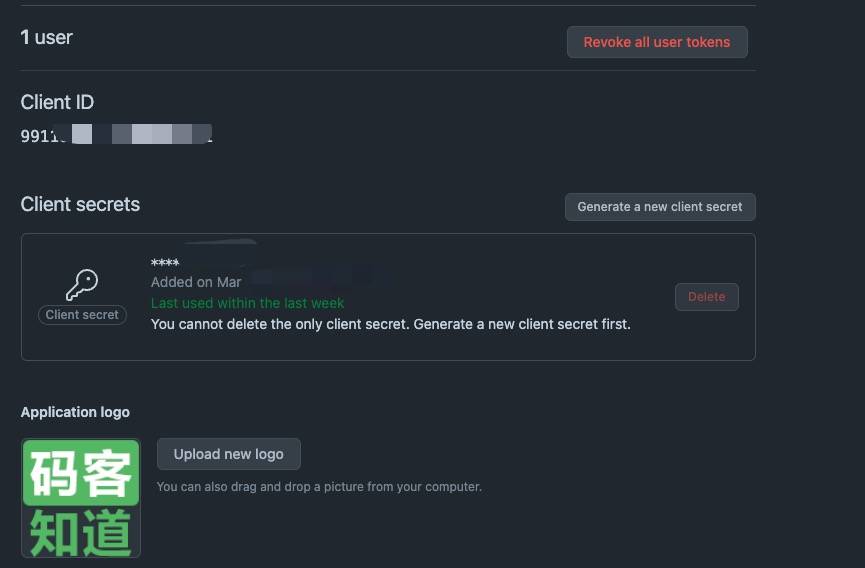
Symfony Security Github登录授权实践
在上一篇文章中介绍了小程序手机号登录的验证器方式。这篇文章中将实现了一个三方Oauth2登录的验证器,主要使用github的登录。
在准备在接入OAuth2登录时,我们需要去对应的服务平台申请应用来获取APP_ID和APP_SECRET等信息,以及需要配置回调地址。
GITHUB
进入Github创建应用,填写完信息后,您将获得需要的基础信息就像这样:

本地调试你只需要把回调地址换成你本地的地址,如: http://localhost:8080/github/callback
OAuth扩展包
OAuth2验证方式是一套标准的流程,PHP社区提供了开箱即用的Composer扩展包,当前比较流行的是league/oauth2-client扩展包。
在你的composer.json文件中加入它们:
{
"require": {
"league/oauth2-github": "*",
"league/oauth2-client": "*"
}
}
不要忘记运行
composer install来安装它们!
验证器入口
可能你的系统又有表单登录,又有三方登录。需要将三方登录的链接渲染到页面中。
use League\OAuth2\Client\Provider\Github;
use Symfony\Bundle\FrameworkBundle\Controller\AbstractController;
use Symfony\Component\Routing\Generator\UrlGeneratorInterface;
use Symfony\Component\HttpFoundation\Response;
#[AsController]
class ConnectController extends AbstractController
{
#[Route('/connect/github', method: ['GET'])]
public function github(): Response
{
$github = new Github([
'clientId' => 'xxxx', // 申请到的APP_ID
'clientSecret' => 'xxxxx', // 申请到的APP_SECRET
'proxy' => '', // 可能你需要科学上网,请配置此处
]);
$options = [
'scope' => ["user:email"],
'redirect_uri' => $this->generate('oauth2_connect_callback',[],UrlGeneratorInterface::ABSOLUTE_URL)
];
$url = $github->getAuthorizationUrl($options);
return $this->redirect($url);
}
#[Route('/connect/github/callback', name: 'oauth2_connect_callback')]
public function callback(string $provider)
{
// 这里不写任何逻辑,逻辑只写在自定义的验证器里面
}
}
验证器类
如果你使用了MakeBundle, 你可以使用以下命令来快速创建。
$ bin/console make:security:custom
What is the class name of the authenticator (e.g. CustomAuthenticator):
> GithubAuthenticator
updated: config/packages/security.yaml
created: src/Security/GithubAuthenticator.php
Success!
// src/Security/GithubAuthenticator.php
<?php
namespace App\Security;
use Symfony\Component\HttpFoundation\JsonResponse;
use Symfony\Component\HttpFoundation\Request;
use Symfony\Component\HttpFoundation\Response;
use Symfony\Component\Security\Core\Authentication\Token\TokenInterface;
use Symfony\Component\Security\Core\Exception\AuthenticationException;
use Symfony\Component\Security\Core\Exception\CustomUserMessageAuthenticationException;
use Symfony\Component\Security\Http\Authenticator\AbstractAuthenticator;
use Symfony\Component\Security\Http\Authenticator\Passport\Badge\UserBadge;
use Symfony\Component\Security\Http\Authenticator\Passport\Passport;
use Symfony\Component\Security\Http\Authenticator\Passport\SelfValidatingPassport;
class GithubAuthenticator extends AbstractAuthenticator
{
public function supports(Request $request): ?bool
{
// 检测怎样的请求才走该验证器
// return $request->headers->has('X-AUTH-TOKEN');
}
public function authenticate(Request $request): Passport
{
// 该方法是验证的主要方法.
// $apiToken = $request->headers->get('X-AUTH-TOKEN');
// if (null === $apiToken) {
// The token header was empty, authentication fails with HTTP Status
// Code 401 "Unauthorized"
// throw new CustomUserMessageAuthenticationException('No API token provided');
// }
// implement your own logic to get the user identifier from `$apiToken`
// e.g. by looking up a user in the database using its API key
// $userIdentifier = /** ... */;
// return new SelfValidatingPassport(new UserBadge($userIdentifier));
}
public function onAuthenticationSuccess(Request $request, TokenInterface $token, string $firewallName): ?Response
{
// on success, let the request continue
return null;
}
public function onAuthenticationFailure(Request $request, AuthenticationException $exception): ?Response
{
$data = [
// you may want to customize or obfuscate the message first
'message' => strtr($exception->getMessageKey(), $exception->getMessageData()),
// or to translate this message
// $this->translator->trans($exception->getMessageKey(), $exception->getMessageData())
];
return new JsonResponse($data, Response::HTTP_UNAUTHORIZED);
}
// public function start(Request $request, AuthenticationException $authException = null): Response
// {
// /**
// * If you would like this class to control what happens when an anonymous user accesses a
// * protected page (e.g. redirect to /login), uncomment this method and make this class
// * implement Symfony\Component\Security\Http\EntryPoint\AuthenticationEntryPointInterface.
// *
// * For more details, see https://symfony.com/doc/current/security/experimental_authenticators.html#configuring-the-authentication-entry-point
// */
// }
}
将security.yaml转化成security.php文件。
# config/packages/security.php
use App\Entity\User;
use App\Security\AccessDeniedHandler;
use App\Security\AuthenticationEntryPoint;
use App\Security\GithubAuthenticator;
use Symfony\Component\DependencyInjection\ContainerBuilder;
use Symfony\Component\Security\Core\Authorization\Voter\AuthenticatedVoter;
use Symfony\Component\Security\Core\User\PasswordAuthenticatedUserInterface;
use Symfony\Component\Security\Http\Authenticator\JsonLoginAuthenticator;
use Symfony\Config\SecurityConfig;
return static function (SecurityConfig $config, ContainerBuilder $builder) {
$firewallConfig = $config->firewall('main');
$firewallConfig
->pattern('.*')
->lazy(true)
->customAuthenticators([
GithubAuthenticator::class,
])
;
};
用户提供商
三方登录之前,我们需要配置好用户提供商,需要为三方登录用户建立用户表。还是使用命令来生成实体类:
$ php bin/console make:user
The name of the security user class (e.g. User) [User]:
> GithubUser
Do you want to store user data in the database (via Doctrine)? (yes/no) [yes]:
> yes
Enter a property name that will be the unique "display" name for the user (e.g. email, username, uuid) [email]:
> email
Will this app need to hash/check user passwords? Choose No if passwords are not needed or will be checked/hashed by some other system (e.g. a single sign-on server).
Does this app need to hash/check user passwords? (yes/no) [yes]:
> yes
created: src/Entity/GithubUser.php
created: src/Repository/GithubUserRepository.php
updated: src/Entity/GithubUser.php
updated: config/packages/security.yaml
Success!
Next Steps:
- Review your new App\Entity\GithubUser class.
- Use make:entity to add more fields to your GithubUser entity and then run make:migration.
- Create a way to authenticate! See https://symfony.com/doc/current/security.html
这里我们的唯一标识字段名为email, Github OAuth登录能拿到email地址。
生成之后不要忘记使用bin/console make:migration && bin/console doctrine:migrations:migrate来构建实体表。
修改security.php文件,将用户提供商加入配置文件中。
// config/packages/security.php
// ...
return static function (SecurityConfig $config, ContainerBuilder $builder) {
$config->provider('app_user_provider')
->entity()
->class(GithubUser::class)
->property('email')
;
$firewallConfig = $config->firewall('main');
$firewallConfig
->pattern('.*')
->lazy(true)
->provider('app_user_provider')
->customAuthenticators([
GithubAuthenticator::class,
])
;
};
修改GithubAuthenticator.php文件,将上面生成的GithubUserRepository类注入到验证器类中。
class GithubAuthenticator extends AbstractAuthenticator
{
private GithubUserRepository $repository;
/**
* 使用构造注入
* @param GithubUserRepository $repository
*/
public function __construct(GithubUserRepository $repository)
{
$this->repository = $repository;
}
// ...
}
验证器逻辑处理
一切准备就绪后,我们就要完成验证器中的验证逻辑。首先需要完成supports方法,之后是authenticate方法。
supports方法表示什么样请求才会经过此验证器处理。
// ...
public function supports(Request $request): bool
{
// 如果URL是`/connect/github/callback`就是github发出来的回调请求
return $request->getPathInfo() === "/connect/github/callback";
}
// ...
authenticate方法只有supports为true才会执行, 它是登录验证的主方法。
现在authenticate方法的逻辑流程是检测code参数是否存在,根据code参数获取accessToken,再根据accessToken获取用户信息,根据用户信息中的email检测表中是否存在此邮箱用户(不存在就新增一条用户记录), 之后返回Passport类。
// src/Security/GithubAuthenticator.php
<?php
use League\OAuth2\Client\Provider\Github;
use League\OAuth2\Client\Provider\GithubResourceOwner;
use Symfony\Component\HttpFoundation\Request;
use Symfony\Component\HttpFoundation\Response;
use Symfony\Component\Routing\Generator\UrlGeneratorInterface;
use Symfony\Component\Routing\RouterInterface;
use Symfony\Component\Security\Core\Exception\AuthenticationException;
use Symfony\Component\Security\Http\Authenticator\AbstractAuthenticator;
use Symfony\Component\Security\Http\Authenticator\Passport\Passport;
use Symfony\Contracts\HttpClient\HttpClientInterface;
use App\Entity\GithubUser;
use App\Repository\GithubUserRepository;
class GithubAuthenticator extends AbstractAuthenticator
{
private GithubUserRepository $repository;
private HttpClientInterface $httpClient;
private RouterInterface $router;
/**
* @param GithubUserRepository $repository
* @param HttpClientInterface $httpClient
* @param RouterInterface $router
*/
public function __construct(GithubUserRepository $repository, HttpClientInterface $httpClient, RouterInterface $router)
{
$this->repository = $repository;
$this->httpClient = $httpClient;
$this->router = $router;
}
public function supports(Request $request): bool
{
// 如果URL是`/connect/github/callback`就是github发出来的回调请求.
return $request->getPathInfo() === "/connect/github/callback";
}
/**
* @param Request $request
* @return Passport
* @throws \Throwable
*/
public function authenticate(Request $request): Passport
{
// TODO: Implement authenticate() method.
$code = $request->get('code');
if (empty($code)) {
throw new AuthenticationException('授权参数解析失败...', Response::HTTP_NOT_ACCEPTABLE);
}
// 根据code先获取accessToken
$github = new Github([
'clientId' => 'xxxx', // 申请到的APP_ID
'clientSecret' => 'xxxxx', // 申请到的APP_SECRET
'proxy' => '', // 可能你需要科学上网,请配置此处
]);
$options = [
'scope' => ["user:email"],
'redirect_uri' => $this->router->generate('oauth2_connect_callback', [], UrlGeneratorInterface::ABSOLUTE_URL),
'code' => $code,
];
$token = $github->getAccessToken('authorization_code', $options);
/**
* @var $resourceOwner GithubResourceOwner
*/
$resourceOwner = $github->getResourceOwner($token);
$email = $resourceOwner->getEmail();
$user = $this->repository->findOneBy(['email' => $email]);
if ($user == null) {
$user = new GithubUser();
$user->setEmail($email);
$user->setRoles([]);
// 请使用passwordHasher接口生成密码
$this->repository->upgradePassword($user, 'xxxxxx');
}
return new SelfValidatingPassport(new UserBadge($user->getEmail(), function (string $email) use ($user) {
return $user;
}));
}
// ...
public function onAuthenticationSuccess(Request $request, \Symfony\Component\Security\Core\Authentication\Token\TokenInterface $token, string $firewallName): ?Response
{
// TODO: Implement onAuthenticationSuccess() method.
}
public function onAuthenticationFailure(Request $request, AuthenticationException $exception): ?Response
{
// TODO: Implement onAuthenticationFailure() method.
}
}
上面就是整个验证的逻辑代码,当然里面还有很多细节未处理。比如accessToken没有保存,没有关联到系统用户上等等。 以上代码不适合在生产环境中运行,可以用来在开发环境的验证逻辑使用。